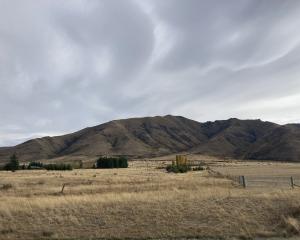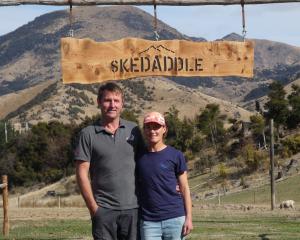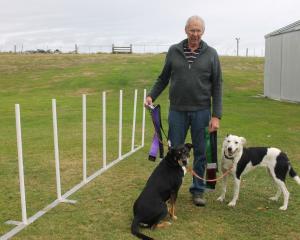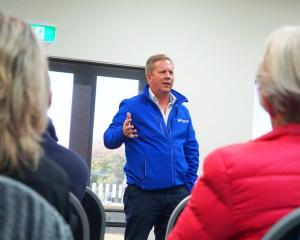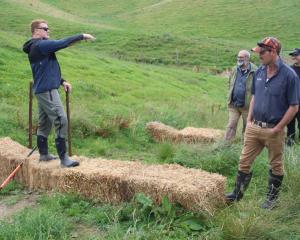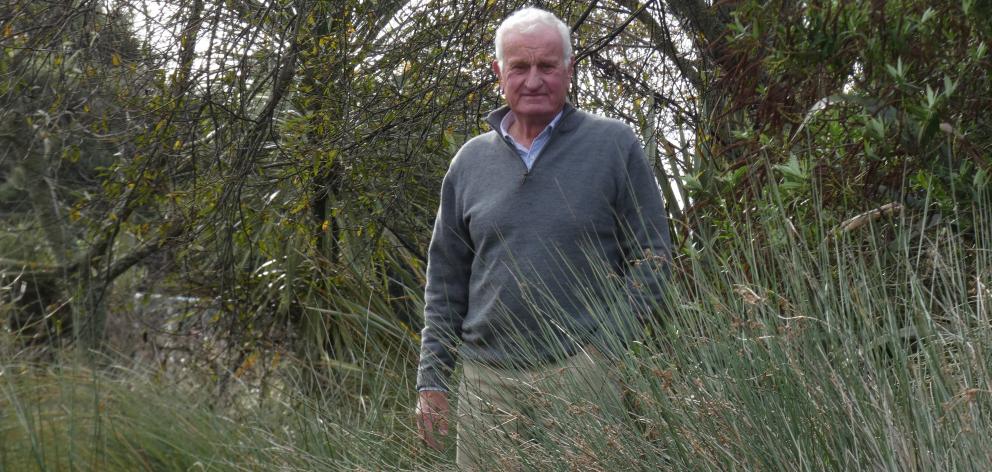
In the quarter of a century that a former Banks Peninsula farmer has kept the Canterbury A&P showgrounds spick and span, there’s one achievement he’s most proud of, writes Tim Cronshaw.
When Dugald Thomas first set foot on the Canterbury Agricultural Park it was a barren, windy dust-bowl.
Today, the 100ha site is the well-groomed home of the Canterbury A&P Show.
The former Banks Peninsula farmer has seen — and been part of — the transformation of the parklands.
Specimen trees have taken root for show visitors seeking shelter from blustery nor’westers and harsh sun. They frame the saleyards, stables and infrastructure.
His favourite spot is just to the side of the showground arena and away from the hullabaloo of the crowds.
Rows of plane trees line a lane after a bridge over Haytons Creek is crossed. The creek used to be an open drain; now it has been softened with fenced stream banks on both sides, shaded in native plants and trees. Lambs being fattened for the works chew happily on pasture and it’s a setting that could be seen anywhere in the countryside.
Except this is on the doorstep of Christchurch and not so long ago was covered in browntop and gorse, and good for little.
This is the happy place of Mr Thomas, who until this month was the Canterbury A&P Association operations manager for the showgrounds.
"There were no trees here at all, it was all bare land. So the A&P association has been responsible for establishing all the trees.
"As far as the association is concerned, this is our proudest achievement because it’s going to be a fabulous asset for the city and the province over the next many hundred years, hopefully."
The dream is for it one day to become another Hagley Park.
"It was unknown this park for many years. Since we came here and since Covid arrived, ironically now it’s been found and there’s hundreds of people walking it every day, which is great."
Trees created enormous atmosphere, he said.
Durable red oaks, pin oaks, scarlet oaks and plane trees are among the thousands of trees planted. Less successful were wind-tender chestnuts.
Initially they were planted as amenity trees until the force of the wind was recognised.
"It’s a very windy site here and trees have struggled to become established. I don’t know why, but it’s probably as windy a place that can be found in Christchurch. Trees don’t like wind in the initial stages and it’s taken a wee bit, but they are past that and are really starting to move now."
His responsibilities included helping to put on the show, and co-ordinating the logistical work and a contract with the city council to manage the park.
As well as hosting New Zealand’s largest A&P show, the grounds are the base for livestock sales, horse sales, equestrian events, junior rugby league games and they are used by many clubs and businesses. In a normal year there might be 25 to 30 events.
"We also farm it too and graze it to keep costs down. Stocking can vary. Before Nga Puna Wai came on board and took 100 acres [40ha] in the far corner [for a sports stadium] we would fatten up to 3000 lambs a year but now we are down to 1000 to 1200 a year."
The A&P association first moved to the park in 1997 after outgrowing its Addington site and owned the site until it became financially strapped. The park was sold to the council and now it is leased.
"It used to be Christchurch Drainage Board land and the A&P association bought it off the board. It was bare, browntop and gorse.
"In one year we got it so we could have a show and over the next four years we kept developing the site pretty much to what it is today although we have added the RDA [exhibitor block] and a couple of stables as well. And then of course we did all the landscaping."
Mr Thomas started off by helping with building fences and other facilities and after two years took on the operations role.
As a boy, he used to visit the show when it was at Addington.
"It is special as it’s the biggest and oldest event in New Zealand. We are 160 years old and second to the [national] Fieldays in Hamilton in regards to size, but for longevity there’s no other event that’s been going for as long as we have.
"To survive for 160 years, I think that’s a huge achievement for the association."
The main motorway heading south veers close to one boundary and will soon be obscured by trees. The arterial route comes in handy for show visitors accessing the site and there is no shortage of parking, unlike its predecessor.
In the beginning, it was surrounded on three sides by paddocks, but has since become enclosed by housing and business and industrial centres.
Visitors probably have little idea of the behind-the-scenes work that goes on before the show.
"It’s a long slog because a lot of the stuff we can’t do in autumn. Most of the work you can only do in the last month leading up to the show so September, October, November you work every day of the week and long hours, but that’s part of the job and the fun of it."
He will miss the people and working with stock, bought from the adjoining saleyards.
Mr Thomas was brought up on a mixed cropping farm just north of Amberley. His father convinced him to move on and "start afresh" rather than being lumbered with a property that had been in the family for more than 100 years so it was sold in the 1980s.
Instead, he went to Banks Peninsula and was a shareholder on a sheep and beef farm in Wainui for nearly 15 years before coming to town in the mid-1990s so his children could get a good education.
He can see now his father made the right call and he was correct, too, in predicting the land would change in some form — it is now in grapes.
One son is farming in Leeston and he hopes to spend more time helping him so he won’t completely step away from farming . He will also continue working at a board level for horse racing.
While he will miss the camaraderie, his retirement won’t see him completely exiting the showgrounds either.
He has already promised to help axe competition organisers set up their site.
No axeman himself, he has always been impressed with the amount of work volunteers do.
"Those guys put in a huge effort to get it up and running. They go through about 1200 blocks during the show. To get all that blocked and peeled and racked is a big job and I’m quite happy to do that and help the committee."
And then there are the memories that will always stay with him.
Special for him had been city children getting to see ewes giving birth in the maternity pen and witnessing the cycle of life. Few would have the chance to go to farms and it was "wonderfully educational" for them to see farming close up, even if it was at a city show, he said.
One memory he would happily forget was the first show at the new site. Widely advertised, too many people turned up and the police insisted the gates be closed at 1pm on Friday.
He had the unenviable task of telling car-loads of would-be show-goers — banked up for miles on Wigram Rd who had been patiently waiting for hours — that they could not enter.
Many had children in the back seat and had come from the likes of Ashburton, Waimate and Geraldine. That was the hardest job he ever had to do.
But this was outweighed by many lighter moments and the many characters he had met, some of them becoming lifelong friends.
He worked with Hawarden farmer and committee member Keith Fincham when putting up the fencing. After putting in a couple of posts, the former Canterbury rugby representative would start telling yarns.
"By the end of it, I would be rolling on the grass laughing and we got nothing done. He played for Canterbury as hooker and if it hadn’t been for Bob Duff he would have been the No1 hooker and all the stories about the rugby trips to the West Coast and Hastings in the 1950s were hilarious. He was a great entertainer and wonderful man. So there were all those people you meet over the time."
Perhaps the funniest thing he ever saw was a certain show exhibitor — who will go unnamed — who had consumed too many drinks the night before.
"Some of the boys got a wee bit tipped up one night so they hooked up his caravan when he was fast asleep and put him in the arena, unhooked it and rode out. Of course, you wake up at 7am and the show’s about to go, he opens up the door and sees he’s in the middle of the arena. The horses were lining up to enter and here’s this caravan out on his own. You probably wouldn’t get away with that now."
From a blank canvas, the park has become an important part of the countryside meeting the city and he is happy to have been a part of that.



